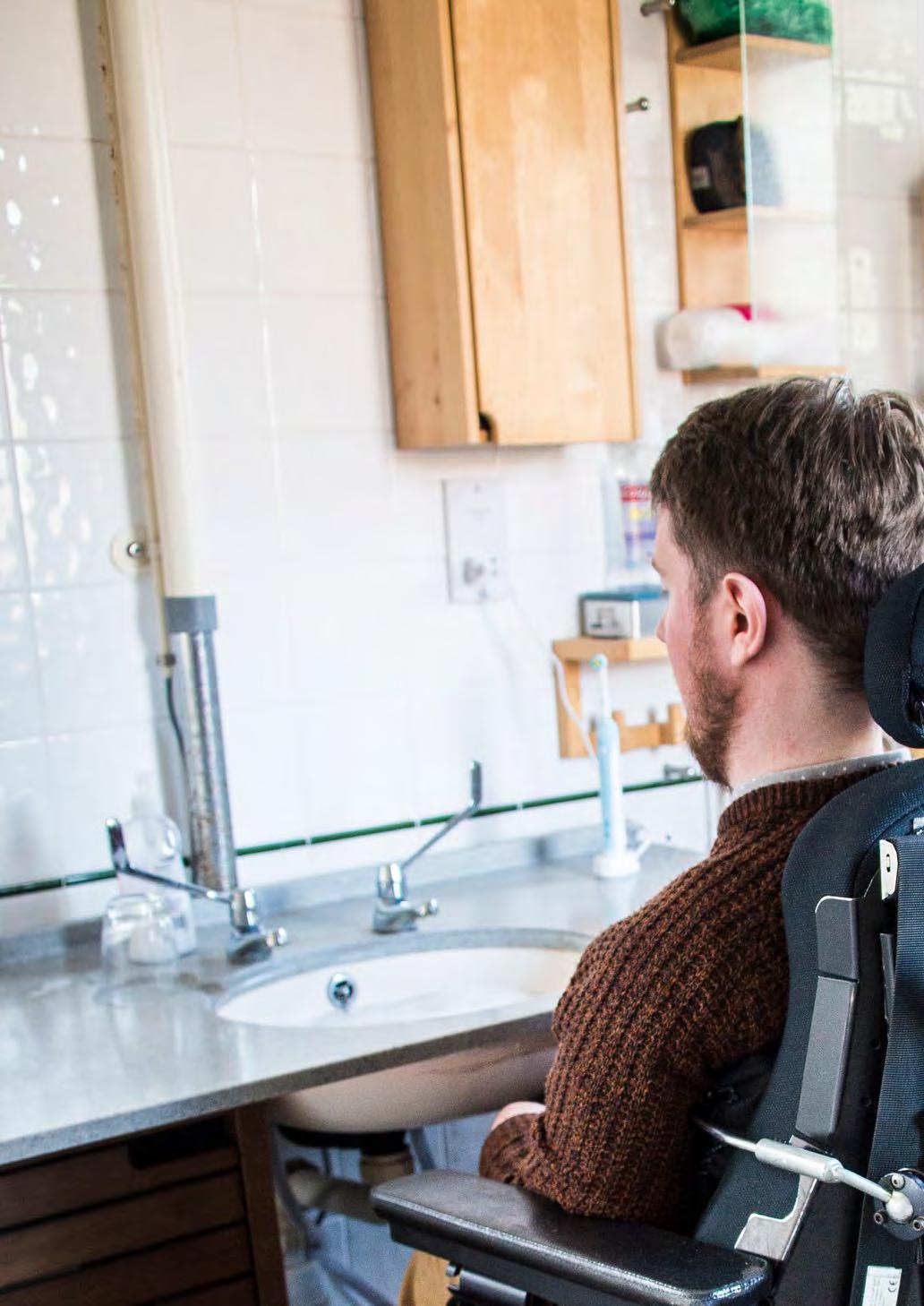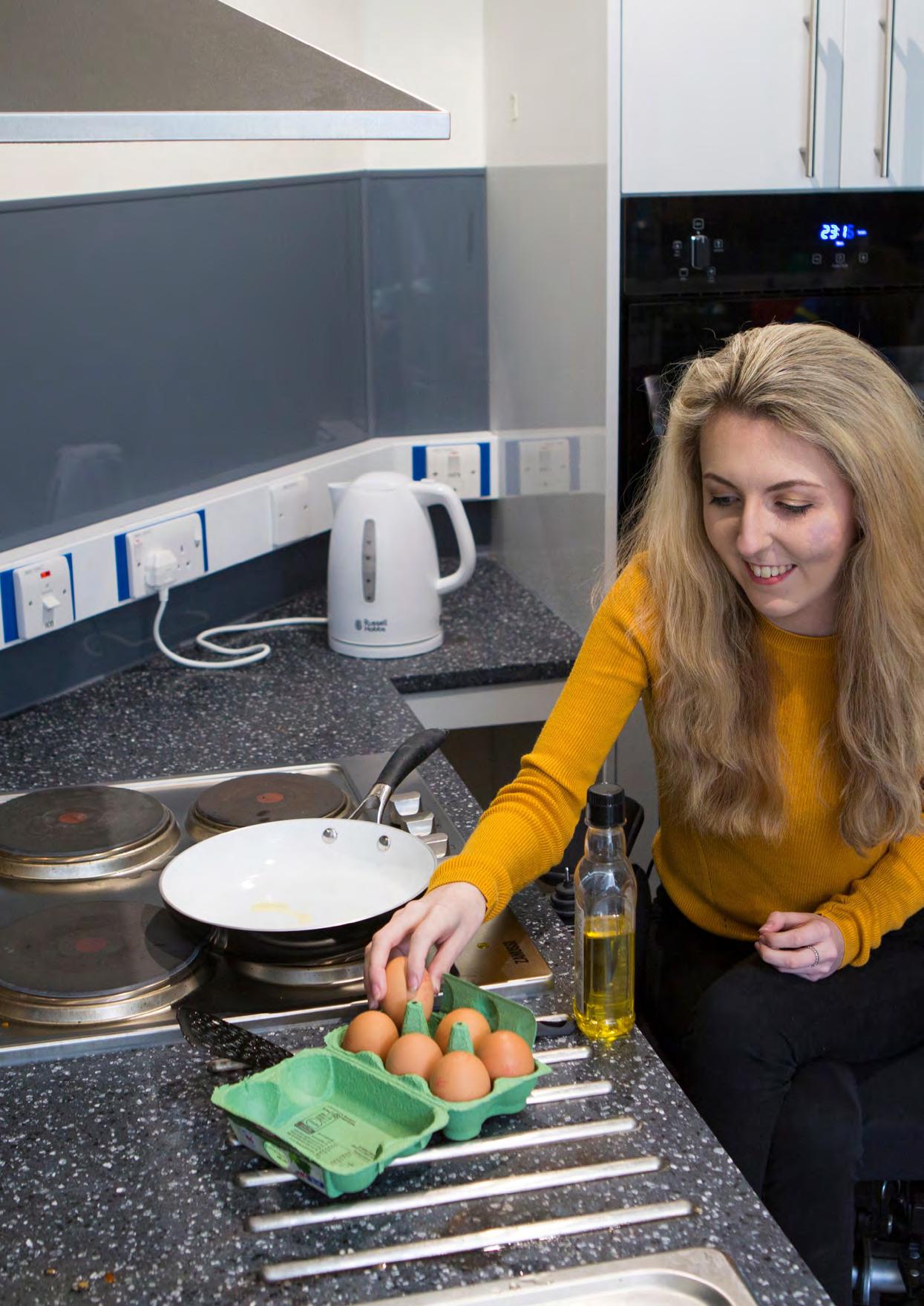
13 minute read
Executive summary
Housing is the cornerstone of independent living, yet many disabled people live in homes that do not meet their requirements. If disabled people are to have choice and control over their lives, then urgent action is required to make sure that future housing supply is accessible for everyone.
In December 2016, the Equality and Human Rights Commission (‘the Commission’) launched a formal inquiry on housing for disabled people. The inquiry examined whether the availability of accessible and adaptable housing, and the support services associated with it, fulfilled disabled people’s rights to independent living.
Advertisement
Disabled people’s rights to independent living are enshrined in the UN Convention on the Rights of Persons with Disabilities (UNCRPD). The principles underlying the Convention recognise that disabled people are the experts in their own lives, and are best placed to identify and determine the housing and support they require. A central approach of this inquiry was to gather evidence from disabled people about their housing experiences. 5
Impact of not having an accessible home
The shortage of housing in Britain has received increasing political and media attention, yet the effects of this crisis are not uniform; the impact of unsuitable housing on disabled people is particularly acute.
Our inquiry uncovered four major challenges, which form the basis of our recommendations:
1. Disabled people are demoralised and frustrated by the housing system
Disabled people report a severe shortage of accessible houses across all tenures. Disabled people are more likely to live in social housing, as it is more affordable, tends to provide more security of tenure, and landlords are more willing to install adaptations and provide support, if required. Social housing is particularly pressured, with long waiting lists. Information on the accessibility of properties is particularly poor in the private sector. Estate agents, for example, do not typically provide information about the accessibility of private lets or houses for sale.
Disabled people can experience serious deterioration in their mental wellbeing due to living in unsuitable accommodation. We heard evidence of people eating, sleeping and bathing in one room. We heard of family members carrying people upstairs and between rooms. The costs of inaccessible housing are well documented, and include impacts on independent living, increased need for social care, more reliance on carers and family members, accidents (including those that are life-changing or fatal) and avoidable hospital admissions.
Social care packages and housing are inextricably linked; sometimes a disabled person’s care package is a crucial factor in ensuring that they can live independently.
Disabled people reported positive housing outcomes where they were able to access wellmanaged local housing and support and advice services, whether voluntary or statutory. Ultimately, finding appropriate, accessible housing can transform people’s lives for the better. Disabled people reported improved health and wellbeing, and enhanced prospects for employment and study where their homes met their accessibility requirements.
In England only
7%
of homes offer minimal accessibility features
2. There is a chronic shortage of accessible homes
Local authorities are not building enough accessible homes to meet demand. The number of disabled people is increasing; in 2016, there were an estimated 13.3 million disabled people in Britain, up from 11.9 million in 2013/14 (ONS, 2017).
Building regulations in England and Wales and, until recently, in Scotland have produced houses that are generally inaccessible, particularly for people who use wheelchairs. The result is that in England only seven per cent of homes offer minimal accessibility features (DCLG, 2015a) and in Scotland only 0.7 per cent of Scottish local authority housing, and 1.5 per cent of housing managed by Registered Social Landlords, is accessible for wheelchair users (Independent Living in Scotland, 2017).
Our survey of local authorities, undertaken as part of our evidential basis for the inquiry, found that the systems used to identify disabled people’s requirements and deliver accessible houses are weak (EHRC, 2018a). Local authorities are making decisions about current need and future demand for accessible houses based on very limited data; only 12 per cent of local authorities rated the data available to them as ‘good’ or ‘very good’.
Few local authorities across Britain set targets for accessible housing and many reported that developers are reluctant to build accessible houses, as they see them as less profitable. There is a notable exception to this in London, where higher accessible and adaptable standards have been the default for the last 10 years. There is strong evidence that housing that meets people’s requirements will save on health and social care costs in the future, as well as considerably lowering the cost of adaptations when they are needed.
Many local authorities reported that developers did not comply with accessibility regulations. Despite this, there were only seven authorities (three per cent) that had taken either formal or informal action against a developer who did not deliver the required number of accessible and/or adaptable properties to the standard required in the last three years.
English local authorities face a particular challenge negotiating with developers, particularly in light of viability appraisals under the National Planning Policy Framework (NPPF) which can act as a barrier in the supply of accessible houses. The perception of local authorities is that current planning policy is weighted in favour of developers, with the emphasis being on the delivery of housing per se rather than the delivery of the right kind of housing. Developers can argue that accessible housing is more expensive and, therefore, less profitable, and negotiate that houses are built to the lowest allowable standards. This imbalance in negotiating power is likely to also be exacerbated by the technical nature of viability assessments, and the lack of expertise within local authorities (and limited funding to externally engage the expertise needed) to properly analyse and, where needed, challenge viability appraisals. 8
68%
of local authorities report that developers do not always comply with accessibility requirements
3 %
had taken action against a developer on accessibility grounds
3. Installing home adaptations involves unacceptable bureaucracy and delay
Not all disabled people need adaptations to their homes, but many do. These adaptations vary from minor changes such as fitting grab rails, to bigger changes such as the installation of stair lifts, wet rooms and hoists. Adaptations can also include adding extra bedrooms, for example for a child with autism who is unable to share with their siblings. There is significant evidence that the timely installation of adaptations creates significant savings to the public purse.
Disabled people are often left waiting for long periods of time, even for minor adaptations. Our survey found that the time between application and installation is, on average, 22 weeks (eight weeks for a decision and 14 weeks for installation), although some local authorities have waiting times of a year or more.
Disabled people face particular problems in the private rented sector, which is growing, especially in England. Disabled people, occupational therapists and local authorities all reported that private sector landlords are reluctant to allow adaptations.
We heard examples of disabled people being prevented from making adaptations to ‘common parts’, for example ramps to a front door.

4. Disabled people are not getting the support that they need to live independently
It takes more than bricks and mortar to ensure that disabled people are able to claim their right to independent living. Access to advice, support and advocacy plays an important role, yet provision is patchy and people report that they have nowhere to turn when their housing is unsuitable, they have difficult choices to make, or they are facing a crisis. A consistent theme from the evidence was that navigating the complex systems for allocations and adaptations was stressful and challenging.
We heard that tenancy support and floating support were particularly important for people with learning disabilities, sensory impairments and mental health conditions; however, changes proposed by the UK Government in policy and funding arrangements have created uncertainty among housing providers. Social housing providers reported that they are finding it increasingly challenging to cover for a failure in services elsewhere, with mental health being a particular concern. This has left a notable gap in support for those in private rented or owner-occupied accommodation.
There is currently a UK Government review of supported housing, about how a wide variety of ‘at risk’ groups can be best supported and the appropriate mechanisms for funding. Our findings have emphasised that choice and control for disabled people are central to realising the right to independent living. These rights should be central to any new policy for supported housing. The current review and pressures on care budgets have led to uncertainty for housing providers. One survey by the National Housing Federation identified that housing providers had put 85 per cent of developments on hold in the course of a year.

Recommendations
The right to independent living recognises that disabled people are experts in determining and promoting better solutions. Governments at national and local level need to be much more effective in engaging disabled people at both at the strategic and operational levels to meaningfully reflect their input, in a continual cycle of improvement.
1. Building more accessible and adaptable homes
• Governments to introduce a national strategy to ensure there is an adequate supply of new houses built to inclusive/universal design standards and to wheelchair-accessible standards, across all tenures. This should include a review of the way that building standards are enforced, particularly in the private rented sector. The strategy should recognise that housing support, advice and advocacy is often necessary to enable people to maintain their housing and their right to independent living.
National and local governments to take action to improve the way that data is collected and shared, both on the requirements of disabled people and on the accessibility of existing housing stock.
In England, we are calling for:
The UK Government to amend requirement M4(2) of Schedule 1 to the Building Regulations 2010 (as amended), so that it is no longer an optional requirement, but instead the default and the mandatory minimum standard for the design and delivery of all new housing. In addition, the UK Government should mandate that all local authorities must ensure a minimum of 10 per cent of new-build houses across all tenure types are built to higher wheelchair-accessible standards (M4(3) design standard). This should be monitored and reviewed.
The UK Government to assess how the Public Sector Equality Duty is complied with, in their review of the National Policy Planning Framework (and practice guidance). It should specify that there is adequate information about the housing requirements of disabled people within Local Plans.
The UK Government to provide mandatory planning guidance for local authorities, giving them a robust methodology for assessing need and delivering accessible and adaptable housing, as well as wheelchair-accessible housing.
The Planning Inspectorate to place more emphasis on meeting its obligations under the Public Sector Equality Duty when dealing with the examination of Local Plans.
In Wales, we are calling for:
Local authorities to meet their duty to publish Equality Impact Assessments alongside their Local Development Plans and Local Housing Market Assessments.
The Welsh Government to require all new homes are built to Development Quality Requirements and to mandate local authorities to ensure that 10 per cent of new homes are built to a wheelchair-accessible standard. This should be monitored and reviewed.
• Local authorities to apply the five ways of working of the W ellbeing of Future Generations (Wales) Act 2015 in their strategic planning for accessible homes, in particular when developing Local Development Plans and Local Housing Market Assessments. This requires them to think about the long term, involve people, prevent problems, collaborate with others and integrate the wellbeing goals into their objectives.
In Scotland, we are calling for:
The Scottish Government to require all local authorities to ensure that a minimum of 10 per cent of new-build homes across all tenure types are built to a wheelchairaccessible standard. This should be monitored and reviewed.
The Scottish Government to amend its Af fordable Housing Supply Programme (AHSP) to enable clear reporting of new-build accessible and wheelchair-accessible housing, including a breakdown of size, property and type.
Local authorities to meet their duty to publish their Equality Impact Assessments alongside their Strategic Housing Strategies and Strategic Housing Investment Plans.
The Scottish Government to undertake a fundamental review of Housing for V arying Needs, ensuring inclusive design and wheelchair accessible design standards to apply across all tenure types.
2. Improving the installation of home adaptations
• Local authorities to urgently address the bureaucratic hurdles and delays that exist within adaptations systems, to ensure that low-cost, minor adaptations in particular can be installed quickly and easily. This should be monitored and reviewed.
Governments to provide additional funding to disabled people’s organisations and advice agencies, to increase the supply of independent advice and information regarding housing options, including adaptations, with a particular focus on the private rented sector.
In England and Wales we are calling for:
The UK Government to review and address the barriers to installing adaptations in the private rented sector, with a particular focus on security of tenure.
The UK Government to implement the duty to make reasonable adjustments to the common parts of leasehold premises, as set out in the provisions of section 36 of the Equality Act 2010 for England and Wales, by the end of 2018.
In Scotland, we are calling for:
The Scottish Government to address the disparity between tenures by reviewing and amending the elements of the Housing (Scotland) Act 2006 that relate to the Scheme of Assistance legislation together with a review of the related funding and guidance, in order to ensure consistency of outcomes, good practice and equal rights for disabled people, regardless of tenure type. The Scottish Government to increase resources available for adaptations across tenures to meet increasing demand.
The Scottish Government to introduce regulations pursuant to section 37 of the Equality Act 2010, which provide that disabled people are entitled to make adjustments to common parts in Scotland.
In Wales, we are calling for:
The Welsh Government to pilot training for private sector landlords on accessibility as part of the Rent Smart Wales scheme, of licensing landlords and agents under the Housing (Wales) Act 2014.
3. Matching homes to the people who need them
Local authorities and Registered Providers of Social Housing/Registered Social Landlords to embed independent living principles into assessment and allocations policies for social housing, to ensure real choice and control.
Local authorities to significantly increase their knowledge of existing accessible social housing stock, and develop specialist support and information services to facilitate suitable matching.
Local authorities to apply best practices on the use of accessible housing registers, with the longer term aim of the use of a standard methodology across all local authorities.
Local authorities to work with the NHS to ensure people living in institutional and residential care are supported to live independently.
Governments to publish standards, and monitor and review the effectiveness of accessible housing registers.
4. Supporting people to live independently
• The UK Government to ensure that the new policy and funding model for supported housing upholds the rights of tenants, and that freedoms and choice are not restricted, in line with the UNCRPD. The new model needs to address the current uncertainty and deliver a stable market for housing providers and those providing specialist support.
• Local authorities to ensure that housing, care and health services are fully integrated and sufficient funds are available to support people to live independently, and that there is an increased focus on prevention.
• Local authorities to provide increased specialist disability advice and advocacy services for housing options.
In England and Wales, we are calling for:
The UK Government to ensure that its review of the Legal Aid, Sentencing and Punishment of Offenders Act 2012 considers the impact of removing housing from the scope of legal aid for disabled people, and takes effective steps to mitigate any identified impacts.










